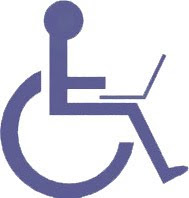
Low Vision Custom Color Settings
Some users with low vision can see content more easily if the default colors are inverted (white text on a black background), customized user styles are applied (blue text on a yellow background, for example), or a custom color scheme is used. This can be done using the operating system, with screen magnification software, or with user style sheets in a web browser. To ensure web accessibility for these users, make sure your page colors have sufficient contrast, that color is not used as the only means of conveying information or meaning, and that colors are specified for page elements (typically using CSS to at least define the page foreground and background colors).
Accessibility, Compliance, and Discrimination
Accessibility is about the user experience. Because a web site can always be more accessible, accessibility is best viewed as being a continuum. Web accessibility guidelines and standards (such as Section 508 and WCAG) provide useful measures along that continuum. Discrimination laws (such as the Americans with Disabilities Act or Section 504 of the Rehabilitation Act), however, generally do not define web accessibility, but instead clarify that web sites should not discriminate based on disability. Because standards and guidelines do not address all aspects of web accessibility, it is possible for a site to comply with a set of guidelines, yet remain very inaccessible to some users and potentially discriminatory. This is particularly true with very minimal standards such as Section 508. For these reasons, it is best to get a true understanding of accessibility and how end users access and use the web. Standards and guidelines should be used as tools and measures of accessibility, but the ultimate goal should not merely be compliance, but to provide an efficient, friendly, and accessible user experience regardless of disability.
Evaluating Web Accessibility with WAVE
WAVE is a free web accessibility evaluation tool found at http://wave.webaim.org/. Rather than providing a complex technical report, WAVE shows the original web page with embedded icons and indicators that reveal the accessibility of that page. This presentation facilitates manual evaluation of web accessibility. A Firefox toolbar version of WAVE allows evaluation of web content directly within the browser - thus allowing sensitive, password protected, dynamic, or intranet pages to be easily evaluated. Because WAVE performs evaluation after page styles (CSS) has been applied and (in the toolbar) after scripting has been processed, WAVE provides a very accurate representation of true end user accessibility.
Evaluating Alternative Text
When evaluating the alternative text of images, remember that the alternative text (whether in the image's alt attribute or in adjacent text) should convey the content and function of an image. Asking the question, "If the image could not be used, what text would replace the image?" is often a good way to determine appropriate alternative text. First, view the alternative text along with the image. Is the alternative text equivalent to the content of the image? Second, disable images and view the alternative text in place of the image and consider if the alternative text makes sense in its context and reading position within the page.
To access the Center for Disability Resources Library and its materials, please click this link
No comments:
Post a Comment